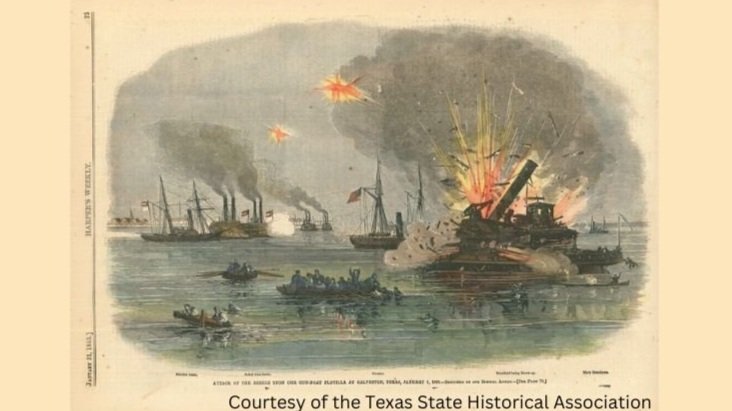
The Civil War & The Battle of Galveston
The Battle of Galveston and the American Civil War in Texas
The American Civil War made its mark in Galveston, Texas. Galveston was a key port for supply lines and cotton exports to fund the Confederate operations. Between 1861 and 1865, the Union Navy organized and implemented blockades against Confederate ports along the Atlantic and Gulf of Mexico. During the Civil War, Galveston was a notoriously tricky port to capture for the Union Navy as Texas was far from the front lines and Union Navy resupply. Local blockade runners were capable of alluding the Union vessels at the mouth of Galveston Bay. The Confederacies' flow of shipments remained steady Until October 1862, when the Union Navy finally seized control of the Port of Galveston.
A detachment of federal troops landed on Kuhn's Wharf, between 18th and 20th Street and the Harbor. The Union troops marched to the customs House at 20th Street and Postoffice to raise the American flag during the federal occupation of the island. Three hundred fifty men of the 42nd Massachusetts regiment tore up the wooden planked approach to Kuhn's Wharf. They erected a barricade with the planks about 100 feet from Strand, leaving only one plank to avoid being overrun by a confederate attack.
The Union Naval forces at the Port of Galveston consisted of six warships, the USS Clifton, Harriet Lane, Westfield, Owasco, Corypheus, and Sachem, spread out at docks along the Port of Galveston to keep watch over the city in Confederate territory.
On New Year's day of 1863, a joint effort between the Confederate Army and a makeshift confederate naval force mounted a surprise attack against the Union vessels in the harbor. The Confederacy devised a plan to sail cotton-clad steamships sailing out of Houston and plan a land-based attack from Galveston Island. These Confederate were steam-powered barges with press cotton stacked around the edges as armor to protect from rifle-shot. The Confederate Army, led by General John Bankhead Magruder, staged his troops and cannons in the Henley Building and other smaller buildings along the waterfront. Moored along the Galveston wharves on New Year's Eve, The Union Navy was not suspecting a landing party from the Confederacy to storm the crude garrison or docked vessels. In the early morning, Confederate Cannon fire erupted on 20th street and Strand towards the U.S. Harriet Lane from the Hendley Building, and the Cotton-Clad steamers named the CS Bayou City and the CS Neptune were coming in hot from Houston. The Confederate naval forces were outnumbered six to two, but the surprise attack against the Union Navy rendered the Naval firepower insignificant. The Union Navy was caught off guard and ill-prepared in terms of ammunition and firepower; the battle of land and sea was short, with most of the casualties on the Union side.
The Confederacy claimed Galveston for the remainder of the war. After this battle, Union forces could never successfully maintain control of the Port of Galveston or confederate shipments through the city. Galveston remained the only significant Confederate port not successfully captured and held during the Civil War. Still standing today, the Hendley building, where the battle was initiated, is located on the corner of 20th Street and Strand. Looking closely at the 20th Street facing side, you can spot cannonball or shell damage on one first-floor pillar. While standing on 20th Street between Harborside and Strand, remember that you are standing on a Civil War battleground, an aspect of the island's history often left out of the conversation.




